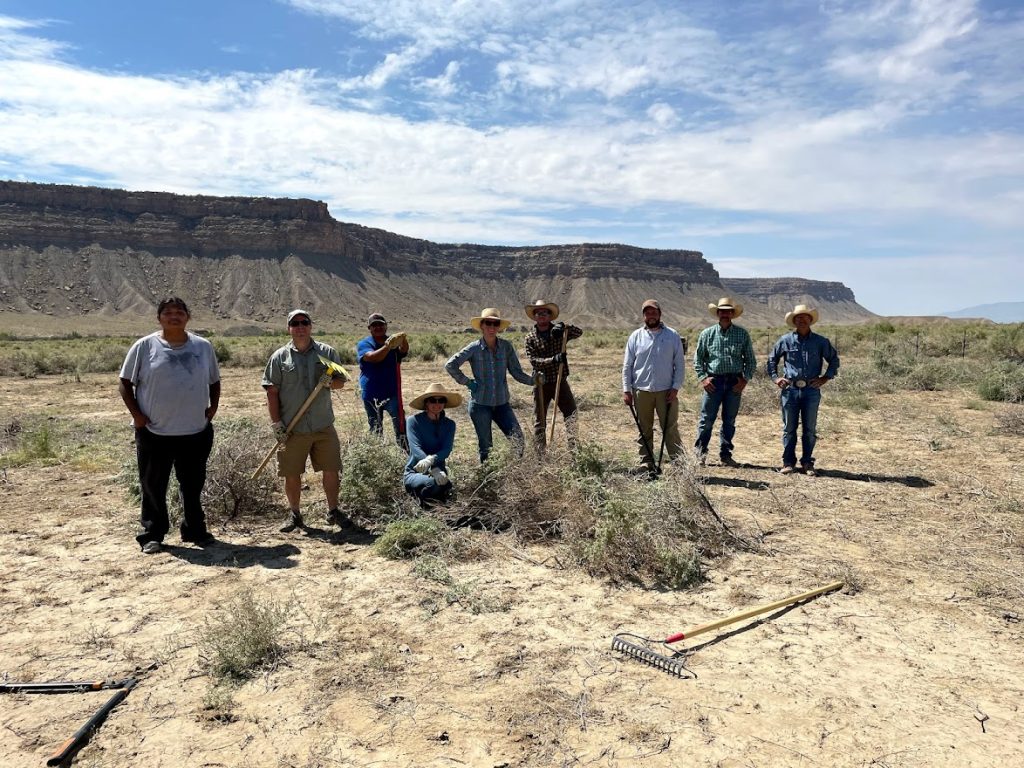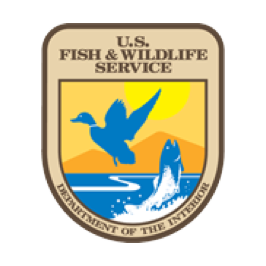Doing More with Less: Inequities in Tribal Fish & Wildlife Funding
The Recovering America’s Wildlife Act is a step towards funding equity
April 5, 2022

Ute Mountain Ute staff and partnering universities design study of dryland restoration strategies in the Mancos Canyon.
There are 574 federally recognized Tribes in the United States. Tribes own or influence the management of nearly 140 million acres. These lands and waters provide habitat for fish and wildlife, including more than 500 species listed as threatened or endangered, as well as first foods, medicines, and cultural and sacred sites for native people. Despite the importance of Tribal natural resource management and role as the first stewards of these lands and waters, there is no dedicated, annual, base-funding for Tribal fish and wildlife management.
For decades, Tribes have been left out of conservation funding opportunities or they are forced to compete for nonrecurring and often inadequate grant funding. One example is the Tribal Wildlife Grants Program (TWG) that is awarded through the U.S. Fish & Wildlife Service (USFWS). While hugely beneficial for the Tribes who receive them, the USFWS receives limited funds each year for the program. In 2021, the program funded 37 (roughly 6%) of the 574 federally recognized Tribes. The labor intensive and highly competitive program leaves many Tribes reluctant to apply, while others simply do not have the capacity to apply.
In 2019, legislation was introduced into Congress, that if passed, would be the first to build Tribal conservation management capacity through secured annual funding. The Recovering America’s Wildlife Act (H.R. 2773, S. 2372) aims to address the shortfall in fish and wildlife conservation funding. The proposed legislation would dedicate $97.5 million to Tribal Nations and $1.3 billion to state agencies to address the need for proactive management to protect the 12,000 fish and wildlife species identified as in greatest conservation need.
Great diversity exists within Tribal fish and wildlife programs. There are Tribes with very well-established programs with large staff and multiple divisions including research, cultural preservation, and animal sanctuaries. Others have no program or are in the beginning stages of developing a program. Each Tribe has unique program goals, priorities, and challenges. Common themes around capacity emerge for a large majority of the Tribes the Native American Fish and Wildlife Society works with – funding instability, staff shortages, and a reliance on grant funding. While it will not address the long history of funding inequities, the Recovering America’s Wildlife Act is an opportunity to begin addressing funding gaps, grow Tribal conservation programs, and improve co-management efforts.
Underfunded, Understaffed, and Overburdened
The Mississippi Band of Choctaw Indians Wildlife and Parks Department manages nearly 40,000 acres with communities spread throughout 10 counties in Mississippi and 1 county in Tennessee. The first thing you notice on a video call with the Program Director, Mitzi Reed, is that she is taking the call from her truck. She doesn’t have an office.
Reed was born and raised on the Choctaw Indian Reservation. After completing her Bachelor and Master’s degrees from the University of West Alabama, she returned home and soon after began working for her Tribe holding many positions in her 21-year career. While working in the Choctaw Environmental Department, Reed experienced firsthand what happens when federal grant funding is lost after the department was shut down in 2006. Fortunately, Chief Philip Martin, a long-time advocate of self-determination, moved her to the wildlife program where Reed developed the conservation programs within the Choctaw Wildlife and Parks Department. She was promoted to Program Director in 2012.
The Choctaw Wildlife and Parks Department is responsible for enforcement of natural resource regulations, endangered species surveys, invasive species management, wildlife animal removals, land use surveys for Tribal development, and youth programming. With a budget of just $650,000 a year, primarily funded through Tribal revenue and federal grants, the department has seven staff members – three wildlife rangers, two animal control officers, a secretary, and the director, Mitzi Reed.
With limited staff and funding, Reed must take on responsibilities beyond her role as Director including, grant and report writing, reviewing Tribal codes and policies, filling in for her staff for animal control, and utilizing her law enforcement credentials to assist the officers. As the only biologist on staff, she is also responsible for all biologist duties. The staff operate out of a 200ft2 office housed in the Choctaw Animal Control Shelter, leaving Reed to do much of her work from her truck.
Asking what a fully staffed department looks like is a hard question to answer, most Tribal fish & wildlife departments have never experienced a fully staffed department. Reed estimates that a fully staffed department would include 12-15 conservation officers, 6 animal control officers, and 6-8 biologists/technicians in different specialties. However, the instability of grant funded positions makes it difficult to hire and retain staff.
“A lot of grants are made to build Tribal capacity, but they don’t exist to sustain Tribal capacity,” said Reed.
As it stands, in accordance with federal Tribal consultation requirements, Tribes are often invited to the table for fish and wildlife management consultations, but many Tribes lack the capacity to participate in these discussions that directly affect them. Without secured annual funding, underfunded and understaffed departments must spend their time applying for highly competitive grants. Even when selected, staff must spend hours reporting and the grants may only cover one or two years’ (or less) worth of project funding.
When asked how the Recovering America’s Wildlife Act would impact the Mississippi Band of Choctaw Tribe, Reed was quick to answer. The priority would be hiring more staff. “You’ve probably heard so many times the term ’game changer,’ but RAWA would be just that. Often, we are able to hire an individual, get them trained and build up that expertise, but then the funding runs out and you may not be able to secure additional funding so that individual leaves to pursue other opportunities. Along with the individual goes the investment of training and expertise, but to be able to retain that individual and continue to build on that expertise…now, that is a gamechanger!”
Grant Reliance Lessens Impact
The Ute Mountain Ute Tribe of southwest Colorado, southeast Utah, and northwest New Mexico manages reservation lands of more than 562,000 acres, fee lands used for ranches, and off-reservation hunting grounds. These lands are critical to the health of many species of conservation concern and the Ute Mountain Ute people. However, the Tribe’s Environmental Programs Department must work hard to retain its small staff who spend much of their time applying for and administering the grants and contracts required to keep it operational.
In 2019, the Ute Mountain Ute Environmental Programs Department hired their first-ever biologist, Hannah Ertl, to lead the Biology Program. The program, tasked with the conservation needs of sensitive and culturally important species and landscapes on Tribal lands, is entirely grant funded.
Ertl estimates that she spends 30-40 percent of her time applying for and administering grants to cover staff salaries and project expenses for conservation planning and restoration. At the time of this interview, the Tribe was relying on 14 grants to fund their program for the 2022 fiscal year and still needed to secure five of these grants. Ertl’s salary is composed of funding from eight different grants, some of which only cover 2-6 weeks of salary. In addition, her technician relies on seven grants for their salary, and the program’s intern depends on four grants for funding. A second intern was let go in December 2021 after insufficient funds were obtained to keep him employed.
Despite funding and staff limitations, Ute Mountain Ute is working on several large research and restoration projects. The staff are responsible for the long-term monitoring of sensitive species including small mammals, rare plants, desert fish, sage grouse, migratory birds, and big game. Their work also focuses on conservation and management planning, and restoration and resilience-building in sensitive and degraded habitats such as riparian areas and pinyon-juniper woodlands. Fortunately, the Tribe has established partnerships with state and federal agencies, non-governmental organizations (NGOs), and universities that assist with some areas of research and landscape restoration.
More than 70 miles of the Mancos River runs through the Ute Mountain Ute Reservation providing habitat for many sensitive and culturally important species. However, much of this habitat is threatened by tamarisk, a heavily invasive species that outcompetes native plants for water and makes lands uninhabitable for other plants by depositing salt in the soil and surface water. Tamarisk can also lower the water table, increasing the impacts of drought. Of the thousands of acres of riparian habitat on the reservation, current grant efforts only manage 95 acres for invasive species removal, and the funding to restore these 95 acres is made up of five different grants. In addition to the time required for large project coordination, each of these grants also requires a substantial amount of time for administration and reporting.
As a grant funded program, time is not the only barrier to accessing funds. Ertl must budget her salary and her crew’s salary into proposals causing the cost-per-acre price of her projects to be higher, and therefore less competitive than those of other applicants with dedicated salary funds. The result is a program constantly struggling to remain afloat despite working diligently to maintain funding and staffing to do this important work.
Ertl reflected on the much greater impact her team would have if they could rely on annual funding through the Recovering America’s Wildlife Act. It would mean more time for surveys, monitoring, conservation planning, and habitat restoration for threatened and culturally important species across a larger acreage. It was a big deal for Ertl to take an hour of her time for this interview, but as she put it, “We need RAWA.”
Getting Started
The Rappahannock Tribe was one of the first communities to encounter European colonizers, including Captain John Smith in 1607. Despite the Tribe’s long history and centuries of fighting for recognition, the Rappahannock Tribe, along with five other Virginia Tribes, only gained federal recognition in 2018.
In October of 2020, the Tribe received a grant from the Environmental Protection Agency’s (EPA) Indian Environmental General Assistance Program (GAP) to establish a Department of Environmental Services. The department has just one staff member, Director Woodie Walker, but substantial goals of bringing Traditional Ecological Knowledge to the management of their historic and contemporary homelands in the Rappahannock and Mattaponi River watersheds.
Unlike the Mississippi Band of Choctaw and Ute Mountain Ute Tribes, the colonization of the Rappahannock predated the creation of reservations and treaty rights. Therefore, the land owned by the Tribe had to be purchased. The Tribe’s 230 acres of rural farmland were purchased with locally generated funds, much of it donated by Tribal citizens.
The EPA GAP program has provided the Rappahannock funds to build an Environmental Department alongside the Tribal Center and establish program goals. Through consultation with elders and community leaders the Tribe identified air and surface water qualities as priorities to address in Year 1 as they impact both environmental and community health. The program continues to grow in Year 2 building from a foundation of Rappahannock citizens. The Tribal Environmental Committee is adding a citizen science program and researching Traditional Ecological Knowledge in fishing, wildlife, logging, and farming. The Tribe is also working to expand partnerships with local grade schools and universities, non-profits, and Tribal, state, and federal agencies.
In this short time, the Tribe is already making large contributions to restoration efforts in their traditional homelands. The Rappahannock are river people, and historic runs of river herring (blueback herring and alewife) were a crucial subsistence food source until the last 25 years, when overharvesting, habitat degradation, and altered waterways drove the fishes to be at risk of extinction. Collaborating with Dr. Henry Legett of the Smithsonian Environmental Research Center (SERC), the Tribe is now contributing crucial Traditional Ecological Knowledge of historic river herring passageways to the management of this culturally important, threatened species.
Ultimately, the Department hopes to partner in the management of land as a continuous habitat, while managing from an Indigenous perspective. However, like the Mississippi Band of Choctaw and Ute Mountain Ute Tribes, the Rappahannock Tribe lacks capacity. With one staff member, who also serves as the Tribe’s historian, the Tribe must be selective in choosing projects and maintaining and developing partnerships, all while working to engage Rappahannock citizenry. The Tribe would like to add air and water quality technicians, a natural resources manager, and environmental educators to its staff, and is seeking associated funding.
If RAWA passes in the 117th Congress, the Rappahannock Tribe will have an opportunity that few other Tribes have experienced – the ability to develop a program with dedicated funding from the beginning. Secured funding would allow greater investment in staff training and expertise, reducing turnover and therefore overall costs. Tribal fish and wildlife professionals will be able to grow their impact with less time spent writing and reporting to grants, expand partnerships and co-management efforts, and maximize the health and cultural well-being of the Rappahannock people.
A Game Changer
Recent studies indicate that lands managed by Indigenous people are higher in biodiversity. The Native Land Information System found that, “While Tribal lands make up 2.6 percent of the United States, they overlap with 12% of Key Biodiversity Areas.” In a time with record level extinctions and species declines, investment in conservation has never been more critical. Tribes are eager to contribute their knowledge and expertise to the proactive management and conservation of wildlife habitat.
The Recovering America’s Wildlife Act is an unseen, historic opportunity to begin addressing inequities in conservation funding. Tribes have tried for decades to be included in federal fish and wildlife funding and RAWA has finally provided that opportunity.
Importantly, the Tribal title of the Recovering America’s Wildlife Act was developed by Tribal fish and wildlife professionals with firsthand knowledge of the needs and challenges of Tribal fish and wildlife departments. The bill provides funding for the conservation or restoration of Tribal species of greatest conservation need identified by Tribes based on biological or cultural importance to the Tribe. Additionally, funds would be available for wildlife conservation education and recreational projects.
Grant funds, including Tribal Wildlife Grants, will continue to be important to Tribal fish and wildlife management, but the guaranteed funds RAWA would provide will improve both the capacity of Tribes to apply and amount of work that can be accomplished. For Tribal Nations, RAWA isn’t just project funding, it is base funding. These funds will increase the dollars that go directly to conservation work, particularly for Tribes that rely solely on grants to fund salaries. It will also aid in the capacity of Tribes to retain staff and engage in the partnerships needed for landscape level conservation and co-management.
While the stories of the Mississippi Band of Choctaw Indians, Ute Mountain Ute Tribe, and Rappahannock Tribe cannot possibly represent the diversity of Tribal conservation efforts, they do serve to demonstrate the value of Tribal fish and wildlife management and the need for dedicated, annual federal funding to develop, grow, and expand these efforts.
To address the wildlife crisis across the country, Tribes must have a seat at the table. And Tribes need the Recovering America’s Wildlife Act.
NEWS RELEASE
Contact: April Richards
Public Information Officer
Native American Fish & Wildlife Society
[email protected], 720-630-3973






